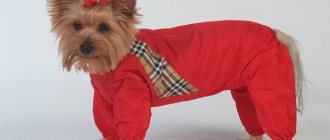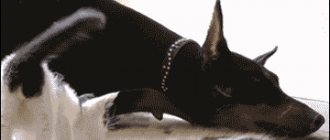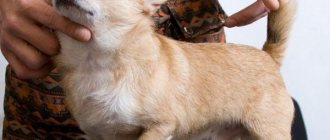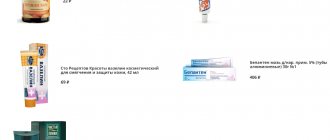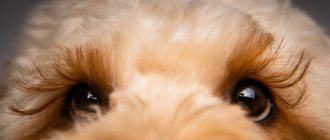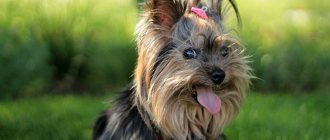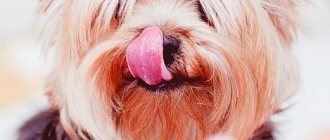The history of the appearance of the smallest dog breed, the Yorkshire Terrier, is associated with its popularity among Scottish and English miners and peasants.
They were specially bred to hunt rats in mines.
The very name of this breed goes back to the county of Yorkshire in northern England. In 1989, the first Yorkshire Terrier club was created.
Nowadays, this dog breed is among the ten most popular among both rich and ordinary people.
In this article we will talk about why and what Yorkshire terriers can get sick with, as well as what to do if your pet is diagnosed with any disease.
Normal temperature for a dog
Normal temperatures are considered to be between 37.7 and 39 °C. It depends on the age, gender, breed and physiological state of the pet. The normal temperature for Yorkshire terriers is 38 - 39 °C; for puppies less than six months old, it can be 39.5 °C.
Table
| Dimensions | Puppies | Adults |
| Small | 38.6 - 39.5°С | 38.5 - 39 °C |
| Average | 38.3 - 39.1°C | 37.5 - 39 °C |
| Large | 38.2 - 39 °C | 37.4 - 38.3 °C |
How to measure at home?
You can find out the temperature of an animal using a regular mercury thermometer. You need to calm the pet and lay it on its side, then generously lubricate the tip of the thermometer and the dog’s anus with Vaseline or oil and, putting on medical gloves and fixing the Yorkie in a lying position, insert the thermometer into the anus so that the tip is completely hidden in the rectum, and wait 3 - 5 minutes.
Temperature should be measured 2 times a day - morning and evening.
What to do if you have fever and chills?
In case of fever and chills, it is necessary to wet the Yorkie's ears, belly and paw pads with cool water, place the dog in a cool room and place a cold compress on its head. There should always be fresh, cool water in your pet's bowl - it is important that your pet drinks regularly.
If non-medicinal methods of reducing the temperature do not help, you should inject 50 ml of saline solution into the withers or a mixture of “No-shpy”, “Analgin” and “Diphenhydramine” intramuscularly.
How to raise the temperature?
If the temperature is below the permissible value, the dog must be warmed up before the veterinarian provides qualified assistance. To do this, you need to wrap your pet in a warm blanket, and place heating pads or hot water bottles under the belly and to the spine.
Skin pathologies
The Yorkshire Terrier has a beautiful, shiny and long coat.
Skin irritations have a negative impact on the dog's appearance.
They can be triggered by factors such as:
- allergy;
- bacterial or fungal infections;
- dermatitis;
- presence of parasites.
As mentioned above, this dog breed is prone to dermatophytosis.
The symptoms of this disease are as follows:
- baldness;
- itching of the skin without lesions;
- claws turn yellow and peel off;
- in severe cases, microspores affect the paw pads.
The parasitic fungus is transmitted from animal to animal. The fungus can cause trichophytosis.
Typically, a specialist prescribes a course of treatment for the animal with Ketonazole, Terbinafine, and Imaverol.
IMPORTANT!
For dermatophytosis, it is necessary to treat the pet with special shampoos, such as Nizoral, and also disinfect the places where the pet sleeps and lives. You can treat the affected areas of the skin with salicylic alcohol, but do not lubricate them with brilliant green or iodine.
Allergy symptoms:
- severe itching;
- salivation;
- Yorkie sneezes and coughs;
- swelling in the throat;
- diarrhea;
- redness of the eyes and watery eyes.
The reasons for this reaction of the body can be different:
- food products;
- plant pollen;
- a bite of an insect;
- household chemicals;
- medicines;
- means for removing fleas.
It must be treated immediately to avoid infection. Wipe the inflammation with vodka or salicylic alcohol, give Suprastin, Diphenhydramine or Tavegil three times a day.
For parasitic skin diseases, the symptoms are as follows:
- ear damage - copious sulfur discharge (otodectosis);
- itching in the neck, head and limbs - the dog scratches itself into wounds (sarcoptic mange).
Treatment is carried out by treating with antiparasitic drugs - Frotline or Advantix, which are dripped onto the withers 2 times a day for a month.
Retinal dysplasia
An abnormality in the development of the retina or dysplasia is a hereditary process that leads to a decrease in visual acuity or its complete loss. Indirect signs of the disease, noticeable at an early stage of its development:
- constantly dilated pupils;
- decreased vision at dusk;
- gray glow of the fundus.
Only an ophthalmologist can accurately diagnose the pathology based on an ophthalmoscopy.
Legg-Calvé-Perthes disease
Aseptic necrosis of the femoral head or Legg-Calvé-Perthes disease is a pathology that affects dogs aged 5-10 months. Symptoms in the form of pain when the hip is abducted to the side, muscle atrophy and lameness begin to appear at 3 - 5 months. Despite the heredity of this disease, the reasons for its development have not been precisely determined.
The main theory is that the blood supply to bone tissue is disrupted, which leads to its necrosis and resorption. This means that there is no inflammatory process during bone destruction. The diagnosis is made based on a series of x-rays of the hip joints, after which the doctor determines a treatment regimen.
What living conditions do Yorkshire Terriers require?
Be sure to give your dog a corner where he can spend time alone. For example, arrange a cozy bed or house for him in a place where there are no drafts. The Yorkshire Terrier also needs separate bowls for food and water, a tray or diaper for the toilet. If the puppy will be left unattended for a long time, you can also set up an enclosure for him.
Toys, for example, made of rope or latex, will help make your Yorkie's leisure time more interesting. Do not give your pet your worn shoes and other things to be torn to pieces, otherwise he will chew everything, not distinguishing between old and new.
Yorkshire Terriers are active animals and enjoy running and walking. To provide them with physical activity, they need at least an hour of daily walks and games in the fresh air. If you do not give these dogs an outlet for their energy, they will find entertainment for themselves in the apartment and will frolic with furniture or shoes.
When packing for a walk, you need to take into account that miniature dogs do not tolerate cold very well and can get sick from hypothermia. Therefore, in rainy or frosty weather it is better to dress them in special overalls and boots. You need to choose clothes and shoes for dogs of the appropriate size, otherwise things will cause discomfort.
find out
